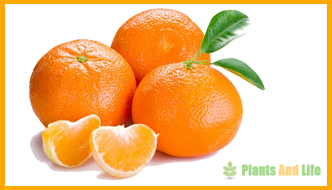
The mandarin is a citrus. It is the fruit of the mandarin tree, a tree in the Rutaceae family.
The fruit with a diameter of 5 to 9 cm is spherical and slightly flattened. Its sweet and fragrant flesh is one of the least acidic among citrus fruits, but it has many seeds. Its bark is fine, a mandarin color.
A tangerine is generally divided into ten neighborhoods. A quarter is sometimes called a shine, a cushion, a thigh or, in Périgord, a "perne", or in Chalais a pod, in Alsace, "a schnitz". and in Mouscron (Belgium), a buttock.
Origin of the name
There are different sources to explain the name given to this fruit, all having in common the title of senior officials of the Chinese Empire: the mandarins. According to some, the fruit was called "mandarin" because the mandarins particularly liked it. Others say it was because the citrus was the color of their officer's dress, or because it was reminiscent of the shape of their face.
Varieties and characteristics
The mandarin has several names, some of which refer to hybrids. Most of the early mandarins are of the Japanese variety "satsuma" which includes about 200 cultivars. The high season mandarins are mainly Mediterranean, including the famous "nadorcott" and the Asian tropical hybrids "ponkan" appreciated in India, Brazil ... Clementine, for its part, is a hybrid between a mandarin and a sweet orange , sought after for its absence of seeds and a more tangy taste. It is the best-selling variety in Europe.
The tangerine can be peeled easily. Starting at the top of the fruit, the quarters can be separated without losing any juice.
Its energy value is around 40 kcal / 100g.
Use
The uses of mandarin are identical to those of orange. It is particularly appreciated as a fruit of the mouth. The bark and juice are used in drinks (liquor, condiments, beer, etc.), in savory and sweet cuisine.
The skin of tangerine can also be used in medical preparations, especially in traditional Chinese medicine.

Conservation
The mandarin keeps for about a week at room temperature. This time can be doubled by placing it in the vegetable drawer of the refrigerator.
Production
The common tangerine is gradually being replaced by its seedless hybrids, notably clementine (hybrid of sweet orange and tangerine) which alone represents 80% of the market for easy peelers in France.
The remaining 20% is mainly occupied by hybrids, mainly clemenvilla (cross of tangelo and clementine), ortanics (hybrids of tangerine and orange), and Orri de Jaffa of recent creation (1990s).
Culture
The tangerine is a small tree with simple shiny dark green leaves. It has only been known in Europe since the beginning of the 19th century.
It is cultivated in Algeria, Spain, Sicily, Tunisia, Morocco and the United States. In areas that are too cold, it is grafted on Poncirus so that it can withstand the harshest winters.

